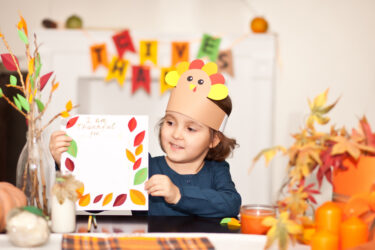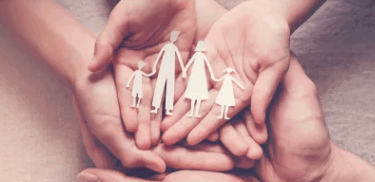Your guide to the funny, exasperating, adorable behaviors children display.
 A normally giggly 2-year-old angrily hurls his sippee cup across the room because it’s the wrong color. An inquisitive 3-year-old peppers you with a non-stop barrage of “Why?”‘s as she puts on her sparkly princess costume. Nearly a big kid, a 4-year-old scores a goal in soccer and gets his own snack from the fridge – but insists on wearing the same threadbare T-shirt every day and sleeping with his favorite stuffed giraffe. It’s just a day in the life of little kids!
A normally giggly 2-year-old angrily hurls his sippee cup across the room because it’s the wrong color. An inquisitive 3-year-old peppers you with a non-stop barrage of “Why?”‘s as she puts on her sparkly princess costume. Nearly a big kid, a 4-year-old scores a goal in soccer and gets his own snack from the fridge – but insists on wearing the same threadbare T-shirt every day and sleeping with his favorite stuffed giraffe. It’s just a day in the life of little kids!
The brief, yet explosive time of rapid physical and emotional development between 18 months and 4 years bridges the gap between toddlers and preschoolers. These little ones aren’t really babies, but aren’t quite big kids either, and their behavior can baffle even the wisest parent.
Age 2 – Rainbows and Thunderstorms
The 2s are often called “terrible,” and they can certainly seem that way in the midst of a shopping mall tantrum. But 2-year-olds – true toddlers – while tyrannical during a meltdown, are usually gregarious and loving, generous with sloppy kisses and prone to fits of laughter over silly faces.
So why do these little love bugs go from docile to difficult in an instant? “Two-year-olds are struggling with the ability to regulate their emotions and behavior,” explains Linda Ashford, Ph.D., a developmental psychologist at the Vanderbilt Center for Child Development and co-author of the parenting book, How Can You Say That? (American Girl, $12.95).
“But the 2-year-old isn’t an expert and vacillates between doing it herself and wanting help; between being carefree and stubborn; between being easily persuaded and digging her heels in,” says Ashford.
It’s up to parents to help toddlers navigate emotional terrain by giving in when it’s harmless or giving children simple choices when one has to be made. The question, “Which socks do you want to wear?” can be overwhelming to a child who’s just realized the ability to make choices at all.
Choices can often result in a meltdown or the snatching of ALL the socks. Selecting the socks yourself can also trigger a tantrum because it stifles your little one’s newfound independence. Hold up two pairs instead and ask, “Would you like the white or the blue today?”
While having Mom and Dad take care of all his needs was comforting as a baby, a toddler – much like a budding teenager – suddenly feels the need to assert his independence, but lacks the complex language skills to make polite requests or negotiate a decision.
The only tool at his disposal is the dreaded word, “No!” Ashford says, “The growth of independence and the drive for autonomy are the hallmarks of this age.” So all those emphatic “No’s” are not only normal, they’re actually a sign of healthy psychological development.
Despite their customary bravado, toddlers frequently become uneasy in unfamiliar situations like visiting a busy store or being left with a stranger and become instant “cling-ons,” insisting on being picked up and toted around. Ashford says, “Children who are appropriately connected with their parents will slip and slide between stages of development, sometimes being totally grown up and at other times wanting to be held like an infant.” Parents should simply coach them to success when they try to do something for themselves and stand ready with a cuddle when they need reassurance.
Occasional tantrums aside, toddlers are an easily amused bunch. Silly faces and antics are always big hits with this crowd, but their favorite jokes usually involve oppositional humor like wearing a sock on your head or putting Daddy’s shoes on a baby doll. “They are just getting used to the way things are supposed to be, so when their expectations are violated, they find it hilarious,” Ashford explains. So the next time your 2-year-old pitches a fit, a dose of slapstick humor might just turn those tears into giggles.
Age 3 – A World of Wonder
Once a child turns 3, he has usually developed a large enough vocabulary to express his frustrations, and tantrums gradually taper off as the year goes by. In fact, his exploding linguistic prowess relates directly to a preschooler’s sense of humor. Phrases that stress alliteration like, “Betty busts her buttons!” or nonsense rhymes like, “Eat with your feet” are absolute side-splitters with this crowd.
And as every weary parent knows, the joke never goes stale. Ashford agrees, “Rhymes can be repeated over and over, always bringing eruption of huge laughter.”
Sharing those jokes with a friend is just one of the wonderful experiences in store for 3-year-olds, who enjoy coloring, swinging and actually sharing toys with kids their age. Unfortunately, these budding socialites still lack the tact and complex language skills to move smoothly between playmates, sometimes resulting in rejection and hurt feelings. If a game between two children is suddenly interrupted by a third child, instead of saying, “I’m playing dolls with Jamie right now, but we can play Legos later,” a 3-year-old may simply say, “Go away. You’re not my friend.”
As distressing as that sounds, Professor Katherine Hoover-Dempsey, Ph.D., associate professor of Psychology and chair of the Department of Psychology and Human Development at Peabody College of Vanderbilt University, assures that it’s perfectly normal.
“At this age, children often forget it a few hours later.” Interestingly, these episodes are more common among little girls. “Girls play in smaller, more infinite groups than boys who rove in herds and gaggles. Boys tend not to focus as much on the person, rather the activity,” explains Hoover-Dempsey.
Do you ever wish you had a nickel for every time your child utters the word “Why?” Well, imagine being in a foreign country where you’re trying desperately to make sense of local customs like refraining from interrupting others or ringing a doorbell before you enter a house, and your only guides to this strange place are your mom and dad. You’d ask them a lot of questions too! “Preschoolers are so amazingly aware of the world and are thinking about things in more interrelated, complex ways,” Hoover-Dempsey says.
Don’t feel like you always have to give a scientific answer to a question like, “Why is the sky blue?” because “Why” questions often just mean, “Tell me more about this topic.” You can talk about birds and planes flying in the sky or how the sky turns pink at dinnertime and black at night. “Why” questions are simply a way for a young child to initiate conversation with you, so just keep talking to him and your 3-year-old will be thrilled.
Talking, non-stop, get-on-your-last-nerve, oh-my-God-my-head-is-going-to-explode talking, is characteristic of most 3-year-olds. But that incessant chatter is a sign of a smart little cookie. Hoover-Dempsey explains, “It’s the exercise of amazing mushrooming language abilities.” And that mental muscle flexing is what leads most kids to continue talking even when no one is listening, or to insert the same new word or phrase into every conversation they have.
“My daughter used to use the word ‘actually’ in almost every sentence because she was so thrilled to have learned such a grown-up word,” recalls Elizabeth Lindsey, mother of 3-year-old Victoria. “She’s actually moved on to the word ‘often’ and uses it as often as possible!” As tiring as all that talking can become, parents should cherish this time of open communication because the time will come when getting a sum total of five words out of your teenager will be an accomplishment.
Age 4 – Ready for Anything
Energetic, silly and willing to try almost anything – that’s most 4-year-olds. They know how to make themselves understood, they understand the basic rules of life, they have a decent grip on their emotions and are ready to experience everything with a smile and can-do attitude.
There’s just one hitch: they can’t hear a word you say. Four-year-olds frequently suffer from the same condition that afflicts grown men during televised football games – selective hearing. Hoover-Dempsey says, “It’s an issue of overload. Children are less able to tune out irrelevant stimuli like television or the presence of an interesting toy.”
She recommends parents “turn off the TV, bend down eye-to-eye with their child and make the statement or question as short as possible.” That means nagging and lecturing will fall upon deaf ears, so keep reprimands brief and to the point.
If your 4-year-old won’t answer when you call, it may very well be because she’s not herself at the moment; she’s Princess Jasmine or Dora the Explorer. Ashford agrees, “By 4, they are always playing another character. Children need to try new and different roles and enjoy the excitement of being an astronaut or firefighter.”
Pretending also helps kids work through past problems, like reenacting a fight with a friend or reliving favorite experiences such as a recent birthday party or vacation. “Giving children lots of literary experiences through books, telling stories and watching good movies will help children develop imaginary play,” Ashford suggests.
It’s a paradox: 4-year-olds have such a zest for life, but are often curious about death. Since most kids have had a pet or family member (like a grandparent) pass away by this age, “What happens when you die?” is a natural question.
Hoover-Dempsey recommends, “Parents need to be clear what their own beliefs are so they can communicate clearly to their children.” She says to avoid relating death to sleeping, since that could trigger bedtime fears, and answer the dreaded, “Are you going to die?” with a simple and reassuring, “No.”
They may ponder serious subjects, but 4-year-olds love to laugh. This gang finds name calling like, “You banana head!” uproariously funny. “Humor is found in people juxtaposing things that are unexpected,” Hoover-Dempsey explains. Potty humor is also popular at this age, but then again bathroom jokes are a staple in both Shakespeare and “Saturday Night Live,” so it’s only natural to laugh at what embarrasses us.
If your preschooler’s poopie jokes are going overboard, gently steer him toward another topic or try calling him a “Hippo kisser” to start a fresh round of cleaner jokes.
Blink and It’s Over
Whether you call them toddlers, preschoolers or just little kids, there’s no doubt that these munchkins are a hilarious handful. While the technical label for this period in life may be fuzzy, one thing is perfectly clear: this time of insatiable curiosity, sudden tears and limitless energy is wildly fun and challenging for parents and children alike, so jump on and enjoy the ride!
Deborah Bohn is a local writer and mother.
HELPFUL READS:
The following books offer insight into toddler development.
Emotional Life of a Toddler
By Alicia F. Lieberman
(Free Press, $14)
The Happiest Toddler on the Block: The New Way to Stop the daily Battle of Wills and reaise a Secure and Well-Behaved One- to Four-Year-Old
By Harvey Karp
(Bantam, $22.95)
The Mother of All Toddler Books
By Ann Douglas
(John Wiley & Sons; $15.99)
The Toddler Journal: A Week-By-Week Guide to Your Toddler’s Development from Ages 1 – 3
By A. Christine Harris
(Chronicle Books, $19.95)
What to Expect: the Toddler Years
By Arlene Eisenberg
(Workman; $16.95)




